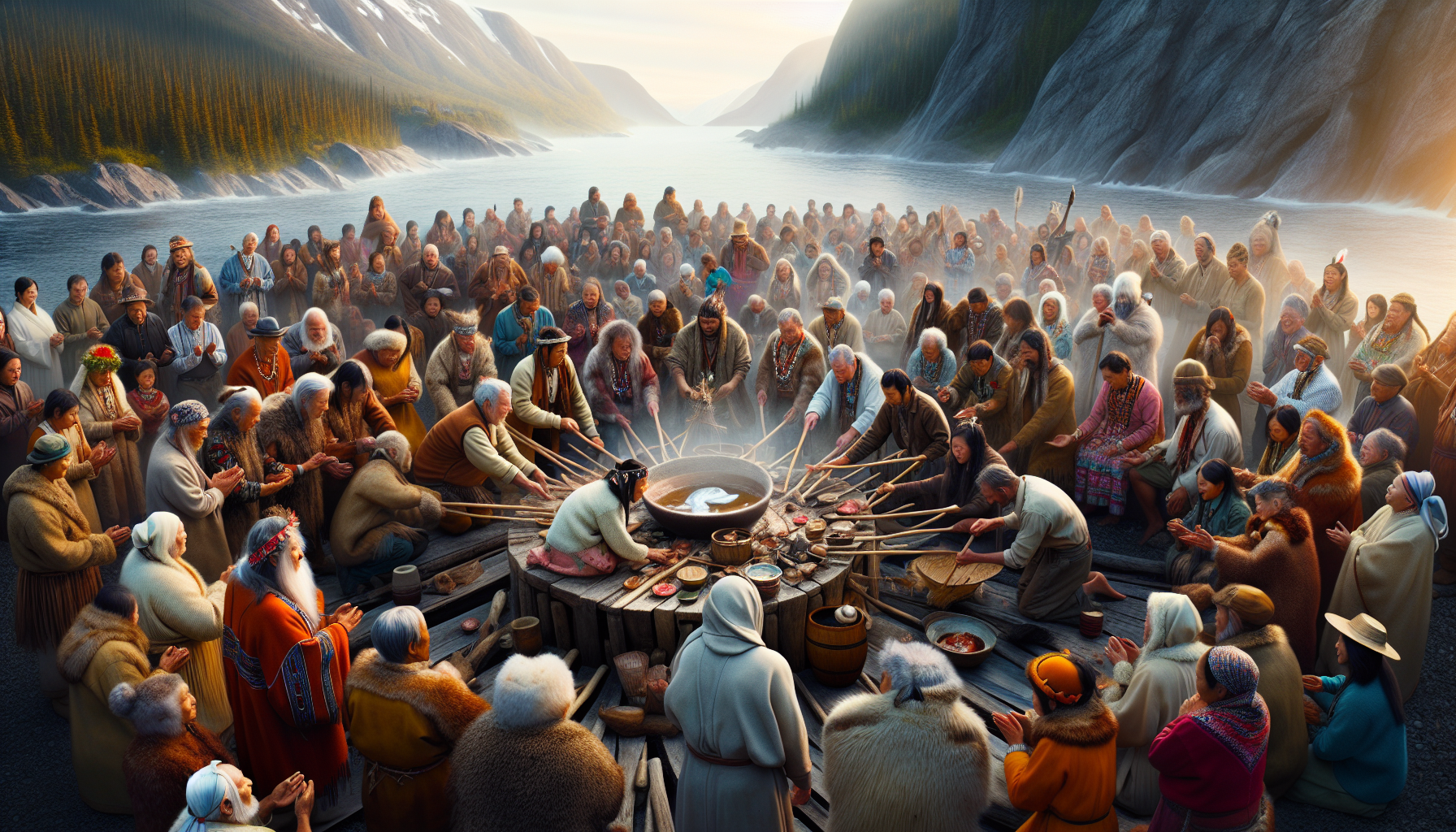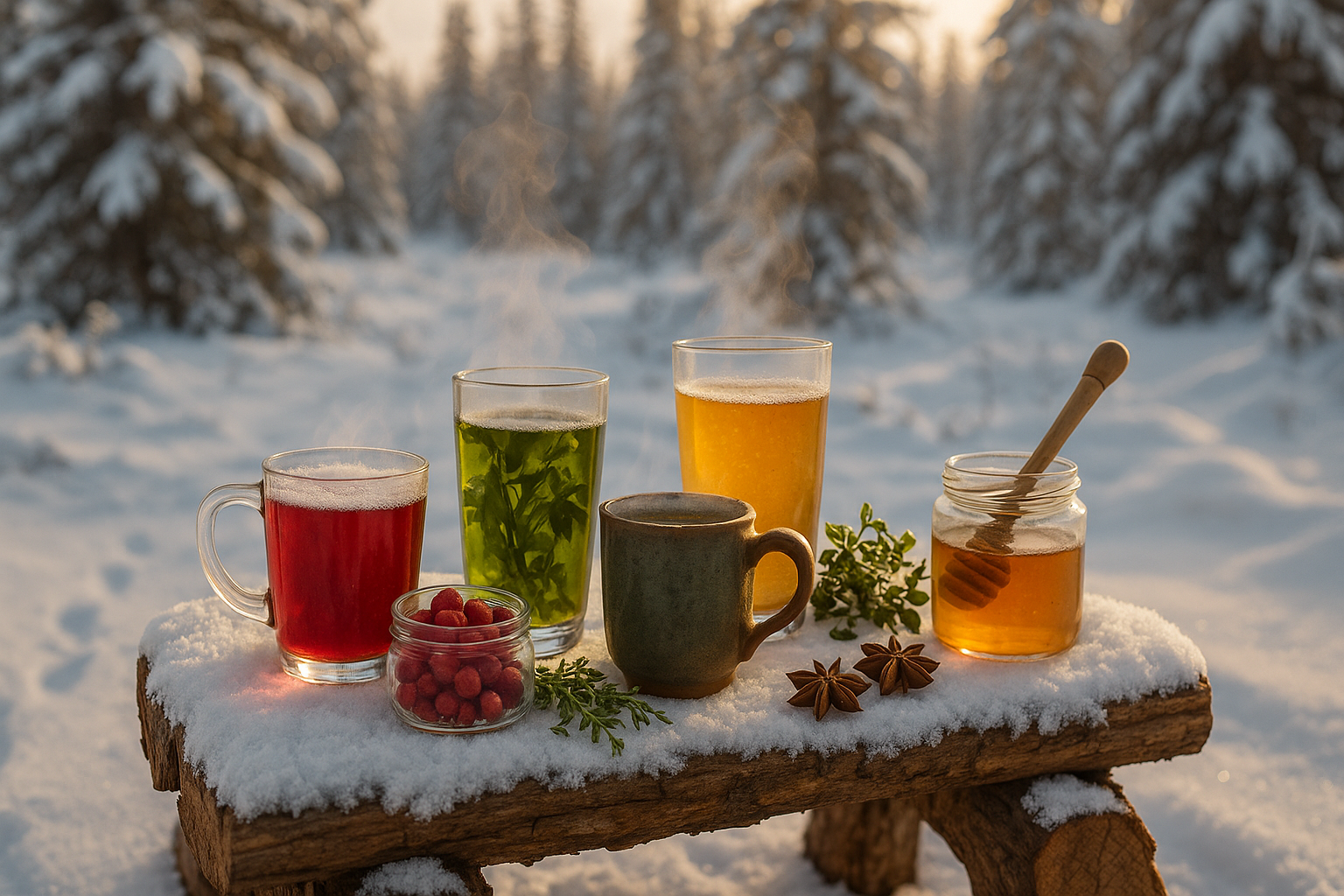In the remote, icy landscapes of the Arctic, where the vast expanses of snow and ice dominate the horizon, a unique tradition unfolds that is as ancient as the communities that call this region home. This is a place where survival is intricately linked to the wisdom passed down through generations, and where the harsh environment is both a challenge and a profound source of connection. Amidst the breathtaking beauty and formidable challenges of the Arctic, the blubber sharing ceremonies stand out as a vibrant testament to the resilience, culture, and unity of the indigenous peoples. 🌨️
These ceremonies, deeply rooted in tradition, are more than just a distribution of resources; they are a celebration of life, community, and cultural heritage. For centuries, indigenous Arctic communities have come together to share the bounty of the whale hunt, an event that is both a means of sustenance and a cultural cornerstone. The sharing of blubber, a vital source of nutrition in this harsh climate, represents a practice where reciprocity and community spirit take center stage. It is a vivid reminder of the interconnectedness of life in the Arctic and the importance of maintaining balance with nature.
In this article, we will delve deep into the significance of these blubber sharing ceremonies, exploring how they have managed to preserve their relevance in a rapidly changing world. We will examine the rich tapestry of customs and rituals that surround the event, highlighting the role they play in fostering unity and continuity within the community. Moreover, we will uncover the challenges these traditions face in the modern era, as globalization and climate change threaten to erode the very foundations of this way of life. 🐋
The Cultural Significance of Blubber Sharing Ceremonies
Blubber sharing ceremonies hold an esteemed place in the traditions of indigenous communities across the Arctic regions. These events are not just about the distribution of whale blubber; they are a profound expression of cultural identity, social solidarity, and communal welfare. For centuries, these ceremonies have served as a pivotal point for community gatherings, reflecting the collective ethos and the intrinsic connection of the people to their environment.
At the heart of blubber sharing ceremonies is the celebration of a successful whale hunt, which is a testament to the community’s skill and cooperation. The whale is seen not just as a resource but as a vital entity that supports life, symbolizing the deep respect and spiritual connection the community has with nature. The distribution of blubber among community members is conducted with great care, ensuring fair and equitable sharing according to traditional laws and customs. This practice reinforces social bonds and provides a tangible link between past and present generations, as these ceremonies often incorporate storytelling, music, and dance, which serve to educate younger members about their heritage.
Moreover, blubber sharing ceremonies are an occasion for reaffirming communal ties and mutual support. In many Arctic communities, survival depends on a strong social network where resources are shared, especially during harsh winters. These ceremonies embody the principle of “collective wealth,” where the well-being of the group takes precedence over individual gain. As such, the act of sharing blubber transcends its immediate nutritional value, becoming a symbolic gesture of generosity and interconnectedness.
The Process of Blubber Sharing
The process of blubber sharing is both a ceremonial and practical event, rich with cultural protocols. Once a whale has been successfully hunted, the community gathers to partake in the careful butchering and distribution of the whale’s parts. This process is meticulous and steeped in tradition, reflecting the community’s respect for the whale and ensuring that nothing goes to waste. The division of blubber is guided by specific roles and responsibilities, often determined by age-old customs that dictate how the whale is to be divided among families.
Traditionally, elders play a significant role in overseeing the ceremony, ensuring that each family receives an appropriate share according to their needs and contribution to the hunt. This distribution not only provides sustenance but also strengthens familial and social bonds, reinforcing the interconnectedness of the community members. Each piece of blubber distributed carries with it the story of the hunt, the skill of the hunters, and the gratitude towards the whale. This profound act of sharing is accompanied by songs, dances, and stories that celebrate the community’s way of life and ensure the transmission of knowledge to future generations.
Table: Traditional Roles in Blubber Sharing Ceremonies
| Role | Description |
|---|---|
| Elders | Guide the ceremony and ensure fair distribution according to tradition. |
| Hunters | Responsible for the successful hunt and are honored for their skills. |
| Youth | Assist in the distribution and learn the traditions and stories associated with the ceremony. |
| Women | Often prepare the blubber for preservation and share in the storytelling. |
Check out the following video to dive deeper into the cultural practices surrounding blubber sharing ceremonies:
Experience Blubber Sharing | [Channel Name]
The Impact of Modernization on Blubber Sharing Traditions
In the face of modernization and globalization, traditional blubber sharing ceremonies are experiencing significant transformations. As these communities engage more with the outside world, they face challenges that threaten their traditional way of life. The introduction of new technologies, shifts in dietary preferences, and regulatory frameworks aimed at wildlife conservation all contribute to changes in how these ceremonies are conducted. While some see these changes as a threat to cultural identity, others view them as an opportunity to adapt and ensure the continuation of their traditions in a modern context.
One of the most significant impacts of modernization is the regulation of whale hunting, which has direct implications for the frequency and scale of blubber sharing ceremonies. International conservation efforts have placed restrictions on whale hunting to protect endangered species, forcing communities to adapt their practices. While these regulations are critical for wildlife conservation, they have also sparked debates about indigenous rights and the preservation of cultural practices. Many communities are actively negotiating with authorities to find a balance that respects both ecological sustainability and cultural traditions.
Additionally, the influx of modern conveniences and dietary shifts has altered the nutritional landscape of Arctic communities. The traditional reliance on blubber and other native foods is being supplemented, and in some cases, replaced by imported goods. This dietary transition poses health risks and threatens the cultural significance of traditional foods. However, it also highlights the resilience of these communities as they strive to maintain their cultural heritage while embracing beneficial aspects of modernization.
Adaptation and Resilience
Despite these challenges, many communities are finding innovative ways to preserve their blubber sharing traditions. By incorporating modern elements into the ceremonies, they are ensuring that these practices remain relevant and engaging for younger generations. This includes utilizing digital media to document and share their cultural practices with a global audience, helping to raise awareness and garner support for indigenous rights.
Furthermore, educational initiatives within these communities are vital in sustaining the cultural knowledge surrounding blubber sharing. Schools and community programs are increasingly focusing on cultural education, teaching young people the skills, stories, and values that underpin their heritage. This educational approach not only empowers the younger generation but also fosters a sense of pride and identity that is crucial for the continuation of these traditions.
Table: Modern Influences on Blubber Sharing Traditions
| Modern Influence | Impact |
|---|---|
| Wildlife Regulations | Reduced hunting opportunities, requiring negotiation for cultural practices. |
| Technological Advancements | Opportunities for digital documentation and global awareness. |
| Dietary Changes | Increased reliance on imported foods, challenging traditional dietary practices. |
| Educational Programs | Enhanced cultural education to empower and engage younger generations. |
To learn more about how modernization is affecting traditional ceremonies, consider watching the following video:
Modern Influences on Tradition | [Channel Name]
The Future of Blubber Sharing Ceremonies
The future of blubber sharing ceremonies hinges on the delicate balance between cultural preservation and adaptation. As indigenous communities navigate the challenges posed by a rapidly changing world, they are actively engaging in discussions and initiatives that aim to protect their cultural heritage while embracing innovation. The role of younger generations in this process is crucial, as they are the torchbearers who will carry forward these traditions into the future.
One promising avenue for the future is the integration of cultural tourism. Many Arctic communities are opening their doors to visitors who are eager to experience and learn about indigenous traditions firsthand. This approach not only generates economic benefits but also fosters cross-cultural understanding and appreciation. By sharing their blubber sharing ceremonies with a wider audience, these communities are reinforcing the value of their cultural practices and promoting sustainable tourism that respects their way of life.
Furthermore, the establishment of cultural centers and museums dedicated to preserving and showcasing indigenous traditions is gaining traction. These institutions serve as repositories of cultural knowledge, housing artifacts, and offering educational programs that highlight the significance of practices like blubber sharing. They play a vital role in ensuring that the rich history and cultural narratives of these communities are preserved for future generations.
Innovative Preservation Strategies
To safeguard the future of blubber sharing ceremonies, communities are also exploring innovative strategies that blend traditional knowledge with modern technology. Digital archiving projects are one such initiative, allowing communities to document their practices and share them through virtual platforms. These digital archives serve as valuable resources for cultural education and provide a means to engage with a global audience.
Collaborations with researchers and conservationists are also proving beneficial. By working together, communities can develop sustainable hunting practices that respect ecological limits while honoring cultural traditions. These partnerships not only enhance the community’s capacity to adapt but also foster mutual respect and understanding between indigenous peoples and the broader society.
Table: Strategies for Preserving Blubber Sharing Ceremonies
| Strategy | Description |
|---|---|
| Cultural Tourism | Engaging visitors to experience and learn about indigenous traditions, promoting cross-cultural understanding. |
| Cultural Centers | Institutions dedicated to preserving and showcasing indigenous traditions and history. |
| Digital Archiving | Documenting cultural practices for education and global engagement through virtual platforms. |
| Collaborative Research | Partnerships with researchers to develop sustainable practices and enhance cultural preservation. |
For further insights into innovative strategies for preserving cultural traditions, check out the following video:
Preserving Traditions Through Innovation | [Channel Name]

Conclusion
**Conclusion: Celebrating Tradition and Community Through Blubber Sharing Ceremonies**
In exploring the rich tapestry of cultural practices that connect communities worldwide, the tradition of blubber sharing ceremonies stands out as a poignant example of how ancient customs continue to unite and define us. Throughout this article, we have delved into the historical significance, cultural nuances, and communal bonds that these ceremonies foster. By celebrating and preserving such traditions, communities not only honor their heritage but also strengthen their collective identity and resilience in the face of modern challenges.
Blubber sharing ceremonies are deeply rooted in the historical practices of Arctic and sub-Arctic indigenous peoples. These ceremonies are not merely about the distribution of resources but serve as a vital communal event that reinforces social bonds and ensures the survival of traditional knowledge. By participating in these rituals, communities pass down essential skills and values to younger generations, ensuring that the knowledge and customs of their ancestors are not lost to time.
The importance of blubber sharing extends beyond the mere act of distribution. It represents a moment of communal gathering where stories are shared, relationships are strengthened, and cultural identity is celebrated. In these gatherings, the community comes together to express gratitude for the bounty of the sea and to reaffirm their connection to the environment that sustains them. This communal aspect is crucial in fostering a sense of belonging and unity among community members, serving as a reminder of their shared history and collective goals.
In addition to their cultural significance, blubber sharing ceremonies also highlight the importance of sustainable practices and the respectful use of natural resources. As the world grapples with environmental challenges, the sustainable harvesting methods used by these communities provide valuable lessons on how to coexist with nature responsibly. By adhering to traditional practices, these communities ensure that their natural resources are preserved for future generations, demonstrating a model of sustainability that can inspire global efforts towards environmental stewardship.
Moreover, these ceremonies underscore the universal human need for connection and community. In a world that is increasingly digital and disconnected, the physical and emotional bonds formed during such gatherings are more important than ever. They remind us of the value of coming together, of sharing not just resources, but also experiences, stories, and emotions. This sense of connection and the reinforcement of community ties can lead to greater social cohesion and resilience, providing a strong foundation for tackling both local and global challenges.
As we reflect on the significance of blubber sharing ceremonies, it is crucial to recognize and respect the cultural heritage and autonomy of the communities that practice them. By supporting their right to preserve and celebrate their traditions, we contribute to the protection of cultural diversity and the promotion of intercultural understanding. This respect and recognition are vital in ensuring that these practices continue to thrive and enrich the global cultural landscape.
To the reader, I encourage you to carry forward the insights gained from this exploration of blubber sharing ceremonies. Whether you are part of a community with its own unique traditions or simply a curious learner, there is much to be gleaned from the values of community, sustainability, and respect for tradition that these ceremonies embody. Consider how you might apply these lessons in your own life, whether through fostering community connections, advocating for sustainable practices, or simply taking the time to learn about and appreciate diverse cultural traditions.
In conclusion, the tradition of blubber sharing ceremonies offers a profound reminder of the enduring power of culture and community. As we navigate the complexities of modern life, let us draw inspiration from these ceremonies and the values they represent. By doing so, we can contribute to a more connected, sustainable, and culturally rich world. Let us celebrate and support these traditions, ensuring that they continue to thrive for generations to come.
Thank you for taking the time to explore this fascinating aspect of cultural heritage. I invite you to share your thoughts and experiences in the comments below, and to share this article with others who might find it insightful and inspiring. Together, we can continue the conversation about the importance of cultural preservation and community connection. 🌍❤️





